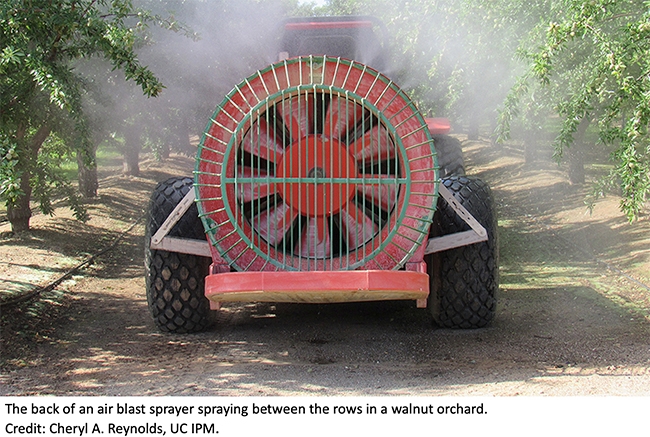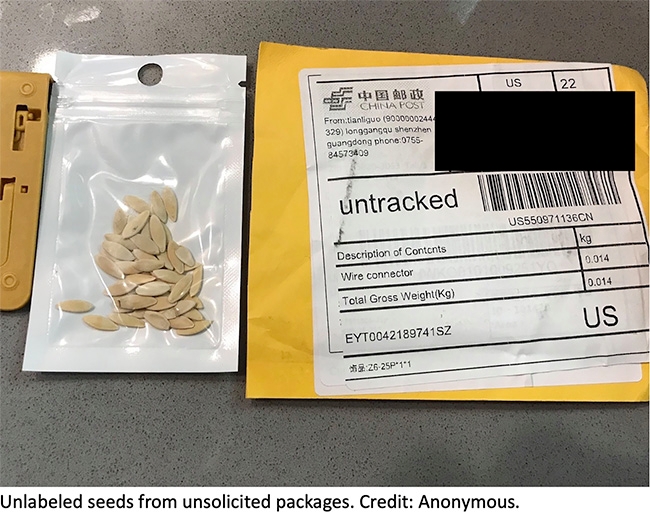- (Public Value) UCANR: Safeguarding abundant and healthy food for all Californians
Author: Petr Kosina, UC Statewide IPM Program
To raise awareness of pesticide safety practices, February is celebrated as National Safety Education Month. This year the University of California Statewide Integrated Pest Management Program offers help to refresh your knowledge about safe and effective pesticide use. Two frequently sought-after online courses focused on proper pesticide use to avoid illegal residues and proper selection, use, and removal of personal protective equipment are offered for free during the month of February. Use code safety100 at checkout to get your continuing education units (CEU) for free.
Pesticides are among the most regulated chemicals in the country. In the United States, the Environmental Protection Agency (EPA) regulates the use of pesticides. All pesticides must be registered with the EPA, and the agency requires a battery of scientific tests to determine the potential risk to humans and the environment. 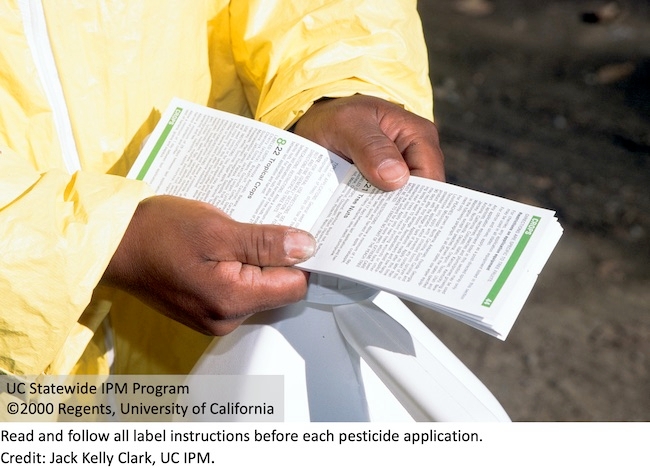
Best practices for using pesticides safely start with reading the label before each pesticide application. How will readingthe label help you? Pesticide labels answer most of the basic questions you need to know about the product, its safe application and handling. Always make applications in strict accordance with all label instructions. Following label instructions will ensure safe, effective, and cost-effective use of the pesticide. Apart from the label, it is important to know what your state regulations are because some state regulations that also have to be observed are not written into the label. Note that not all pesticides approved by the EPA and available for purchase in the United States can be used in California. California is one of the few states that have more strict pesticide regulations for certain pesticides than what is required by the EPA. Even if you have used a given pesticide in the past, make sure you have an up-to-date label, as EPA may occasionally change labels. To learn more about pesticide labels and how to extract information relevant to the specific setting and situation in order to apply pesticides safely, enroll in the online course Proper Pesticide Use to Avoid Illegal Residues. Pest management professionals will earn 2.0 hours of Laws & Regs CEUs.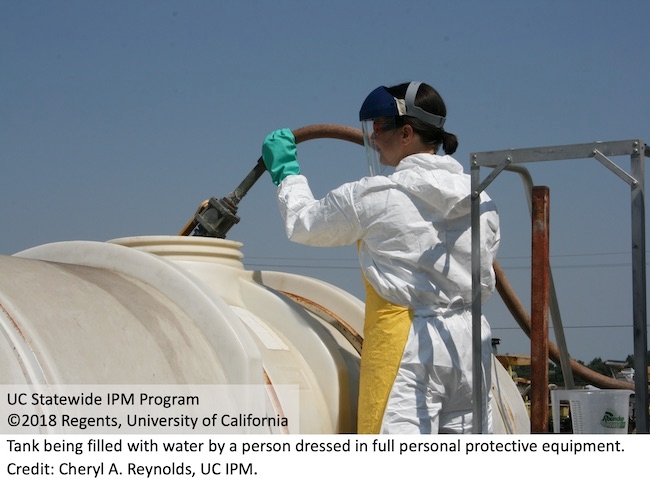
Because pesticides have the potential to cause injury or illness to anyone working with them, it is important to wear personal protective equipment, or PPE, to reduce a person's exposure to pesticides. PPE includes clothing and certain devices worn to protect the human body from contact with pesticides or pesticide residues. Regular clothing is not considered PPE even though some pesticide labels may indicate that these specific items of regular work clothes can be worn during certain activities. All employees who handle pesticides in California are legally required to wear PPE. They must follow all PPE instructions on the pesticide label and follow all California laws and regulations. To learn how to select the proper PPE, use it, remove it, and dispose of it or clean and store it before, during, and after each incidence of pesticide handling and application, enroll in the online course Proper Selection, Use, and Removal of Personal Protective Equipment (PPE). Pest management professionals will earn 1.5 hours of Laws & Regs CEUs.
Visit the UC IPM website to see all 22 online courses that are available for continuing education credit.
- Author: Nicki Anderson
There's a new group just for you being formed in Ventura County.
Join us for an evening of farmer focused conversation. Meet your fellow farmers and connect with others who work in agriculture in our region. The goal is to offer space for farmers to convene and converse. While we might occasionally come into contact with each other at field days, events and meetings, it's also nice to have the opportunity to check-in with fellow growers.
The motivations for this occurrence builds upon inspiration from the Lighthouse Farm Network, organized by CAFF starting in the early 1990s, where farmers would meet around meals to share ideas and strategies for sustainable production.This type of farmer-focused organizing is nothing new in the [(tens of) thousands of] years of agriculture. In this country especially, farmers once were deeply involved in government and economy leadership.
*Cue* George Washington's words:
“Agriculture is the most Healthful, most Useful and most Noble Employment of Man.”
While our biggest obstacles may be seem different from what they have been in the past, today's challenges seem to be moving much faster, are in greater numbers, and are drastically more unforgiving in their devastation. As climates of all types (social, environmental and political) are rapidly shifting, it is important to recognize the varying qualities and values our region has to offer, as well as the obstacles and risks we have to face. As keen observers to the rhythms and patterns of soil, plants, animals, weather, etc, farmers are often the first to notice small differences, and draw from real life experiences working every day in a world that is rapidly changing. In addition to creating connections, these meetings also bring fresh perspective and new confidence for what can happen, creating opportunity for knowledge and experience to be shared.
The kick-off launch party will occur on Friday, June 11, 6pm - 8pm, at McGrath Family Farm in Camarillo. There will be food and beverages, but you're welcome to bring your own!
Please let us know you are coming and reserve your spot by registering HERE
- Author: Cheryl Reynolds
We're excited to announce that a brand-new online course on air blast spray calibration is now available. This course was developed by Lynn Wunderlich, University of California Cooperative Extension (UCCE) farm advisor for the Central Sierra, and Franz Niederholzer, UCCE farm advisor for Colusa, Sutter, and Yuba counties.
If you are a grower, pest control adviser, or pesticide applicator working in trees and vines, then this course is for you! You will learn the basic principles of spray calibration, take a close look at the basic components of a sprayer, perform calculations needed for calibration, and take a look at how factors such as droplet size, nozzle type, and weather conditions influence drift and spray coverage. This course also explains the conditions for pesticide applications under the 2018 Pesticide Use Near Schoolsites regulation. Air Blast Spray Calibration has been approved by DPR for a total of 2.5 continuing education units (CEUs), including 0.5 hour of Pesticide Laws and Regulations and 2.0 hours of Other.
Fall is here and 2020 is winding down; it's time to complete your continuing education units and submit your California Department of Pesticide Regulation (DPR) renewal packet. If you are a DPR license or certificate holder and your last name begins with the letters A through L, then 2020 is your year to renew. Renewing now guarantees a quick turnaround time and having enough time to resolve any problems before your license expires. DPR encourages all license holders to send in renewals November 1 to ensure license renewal by January 1, 2021. Why not check out the online courses the UC Statewide IPM Program (UC IPM) has to offer?
Four of UC IPM's most-wanted courses are offered at an early-bird price until November 1st! You can save an additional $20 by purchasing the 4-course bundle for only $85 rather than each course individually.
- Proper Pesticide Use to Avoid Illegal Residues (2 hours Laws and Regulations – early-bird price $40; full price $80)
- Proper Selection, Use, and Removal of Personal Protective Equipment (1.5 hours Laws and Regulations – early-bird price $30; full price $60)
- Pesticide Resistance (2 hours Other – early-bird price $20; full price $40)
- Pesticide Application Equipment and Calibration (1.5 hours Other – early-bird price $15; full price $30)
Many of our courses are now credited not only by DPR for continuing education hours, and also by the California Structural Pest Control Board (SPCB), Certified Crop Advisor (CCA), the Western Chapter of the International Society of Arboriculture (WCISA), and the Arizona Department of Agriculture.
- Author: UC Integrated Pest Management
Have you had unexpected seeds show up in the mail? Unknown seeds could be invasive plants, contain invasive insects, or have plant disease causing agents. Here's what the United States Department of Agriculture Animal Plant and Health Inspection Service (USDA APHIS) has to say about it.
USDA Investigates Packages of Unsolicited Seeds
USDA is aware that people across the country have received suspicious, unsolicited packages of seed that appear to be coming from China. USDA's Animal and Plant Health Inspection Service (APHIS) is working closely with the Department of Homeland Security's Customs and Border Protection, other federal agencies, and State departments of agriculture to investigate the situation.
USDA urges anyone who receives an unsolicited package of seeds to immediately contact their State plant regulatory official or APHIS State plant health director. Please hold onto the seeds and packaging, including the mailing label, until someone from your State department of agriculture or APHIS contacts you with further instructions. Do not plant seeds from unknown origins.
At this time, [USDA does not] have any evidence indicating this is something other than a “brushing scam” where people receive unsolicited items from a seller who then posts false customer reviews to boost sales. USDA is currently collecting seed packages from recipients and will test their contents and determine if they contain anything that could be of concern to U.S. agriculture or the environment.
USDA is committed to preventing the unlawful entry of prohibited seeds and protecting U.S. agriculture from invasive pests and noxious weeds. Visit the APHIS' website to learn more about USDA's efforts to stop agricultural smuggling and promote trade compliance.
- Author: Rose Marie Hayden-Smith
Learn About California Agriculture
Join us on Thursday, May 21st, 9:30 am PST, for Part 2 of a webinar series on California agriculture, where we'll learn about major crops and production areas. This webinar will feature UCCE Ventura County advisors Andre Biscaro and Ben Faber. Watch it live or view after on YouTube. Part 1 is up. This is an ideal webinar series for the home classroom.
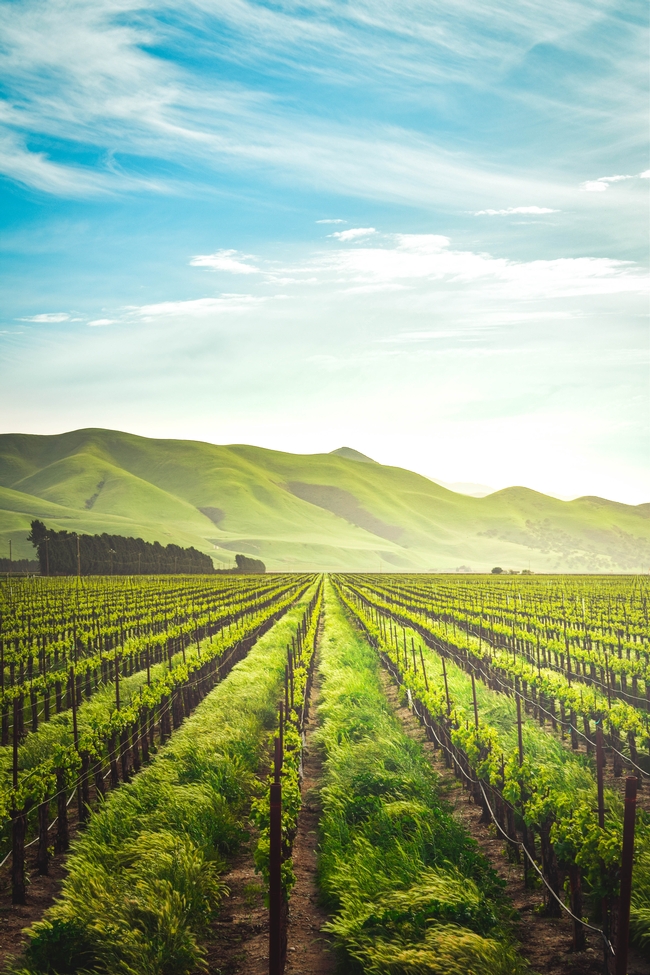
Fumigants and Non-Fumigant Alternatives: Regulatory & Research Updates
Growers, PCAs, applicators and supervisors of fumigant and non-fumigant technologies and decision makers should plan to attend this free, virtual educational outreach event, scheduled for Monday May 29th from 8:00 a.m. to 12:00 p.m. This workshop is open to the public. Although targeted to strawberries, most of the learning will generally apply to other crops. The program is being hosted by Dr. Oleg Daugovish, who serves as the Strawberry and Vegetable Crop Advisor for UCCE Ventura County.
Topics include:
- Most pertinent regulatory requirements for fumigant use and application
- Industry updates on fumigant and non-fumigant tools use
- Fumigant application based on need within fields
- Soil-borne pathogen management
Continuing Education Units are available: 1.5 hours of "Other" and 1.0 hours of laws and regulations have been applied for from California Department of Pesticide Regulation (DPR).
Registration is required and participants will receive a link and instructions prior to the workshop. Register here.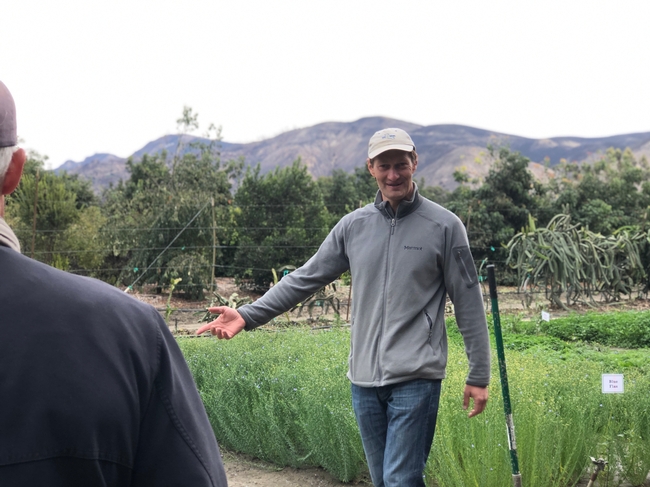
Announcing Treemendous Learning Webinars for Middle and High School Students
Join us on alternate Tuesdays in May and June, 3:00 pm to 4:00 pm, for this opportunity designed for middle and high school students. Treemendous Tuesdays is a collaboration of U.S. Forest Service, Los Angeles Center for Urban Natural Resources, California Project Learning Tree, California 4-H, and UC Agriculture & Natural Resources
Five webinars will be hosted every other week starting May 5 and ending June 30. These events are free and registration is required.
- May 5: Invasive Species (invasive shot hole borers)
- May 19: Invasive Plants & Trees
- June 2: Benefits of the Urban Forest
- June 16: iTree
- June 30: Living with Fire
Register at https://ucanr.edu/survey/survey.cfm?surveynumber=29846
New Resource to Diagnose and Manage Plant Disease
UC's Integrated Pest Management Program has a new Pest Notes publication available, which provides information to help diagnose and manage Anthracnose, fungal diseases that can impact many deciduous and evergreen trees and shrubs. These diseases can also infect vegetables, flowers, fruit and turfgrass in some regions in California. Dr. Jim Downer, an Advisor in our UCCE Ventura County office, is a co-author.
Preparing for Fire Season
UC ANR has organized an electronic portal - Homeowner's Wildfire Mitigation Guide - that contains a wealth of resources to help homewoners prepare for fire season. Please visit our Fire Resources and Information page for the latest research and information.
Follow Us on Facebook and Instagram
We'd love to interact with you on social media. Like our Facebook page and visit us on Instagram.


